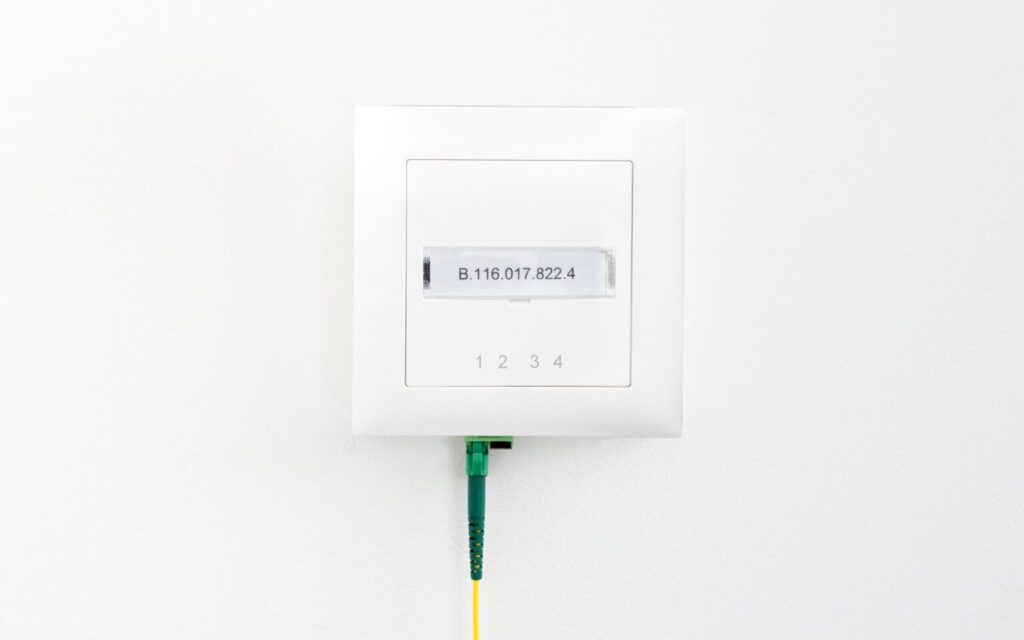How to read your OTO-ID
Every home with fibre-optic access has a corresponding “fibre-optic socket”, a so-called OTO socket (OTO = Optical Telecommunications Outlet). Each OTO socket has four plugs and an identification number, the OTO-ID. The OTO-ID is based on a specific system. In this article, we explain the method used to determine the OTO-ID and what information can be read from it.
Guidelines ensure coordinated roll-out of fibre-optic networks
In 2008, the Federal Communications Commission (ComCom) and the Federal Office of Communications (OFCOM) set up a so-called “Round Table” to ensure a uniform and coordinated roll-out of fibre-optic networks. The most important players in fibre-optic expansion agreed on uniform standards.
In addition, “FTTH working groups” were formed to draw up technical, logistical and contractual recommendations for the network operators, including technical guidelines concerning FTTH in-house installations. These guidelines regulate, among other things, how fibre-optic connections are labelled and how the OTO-ID is created.
The Round Table was successfully concluded in 2012. ComCom and OFCOM announced that the objectives had been achieved and that they therefore saw no need for further discussions.
The four sections of the OTO-ID

Version
Each OTO-ID consists of eleven digits. The first digit indicates the version of the system on which the OTO-ID is based. The current system is identified by the letter B.
Operator number
The next three digits indicate the network operator who originally built the FTTH in-house network. For example, 116 is the operator number of Stadtwerk Winterthur. A list of all operator numbers can be found on the OFCOM website.
Identification number
The following six digits designate the OTO socket per operator. Each network operator determines the method on which the identification number is based. For example, whether to simply count up from 000.001 or whether there are certain subsections. Network operators with more than 999,999 OTO sockets receive several operator numbers.
Check sum
The last digit serves as a check sum and prevents errors, for example due to swapped digits or typing errors. The check sum is based on the MOD11 algorithm and can be calculated as follows:
1. Take the operator and identification number.
-> E.g.: 116.123.456
2. Multiply each digit by its position and add up the results.
-> (1×1)+(2×1)+(3×6)+(4×1)+(5×2)+(6×3)+(7×4)+(8×5)+(9×6) = 175
3. Divide the result by 11.
-> 175/11 = 15.909091
4. The decimal places are relevant for the check sum. Round up to the first digit after the decimal point. This is the check sum.
-> In our example, it should be rounded up to 10, which is represented by the letter X. If the result was 15.809091, the check sum would be 9.
Your network operator is not necessarily your internet provider
The OTO ID shows who originally built the fibre-optic network. However, this does not mean that services cannot be obtained via another provider.
Network operators rent out their connections (i.e. their infrastructure) to other providers, so-called cooperation partners. They either rent out the unlit optical fibre (OSI layer 1) or they rent out the optical fibre including an existing service (OSI layer 2).
As all OTO sockets generally have 4 fibre-optic connections (of which only 2 are usually fully developed), 4 providers have access to one customer at the same time. However, it’s also possible to change your internet provider with just one fibre per home. In this case, the fibre is switched from one provider to the other in the respective point of presence (PoP).
Our blog article on the Federal Strategy for a Very High Capacity Network (in German) provides further information on the expansion of the internet infrastructure in Switzerland.
Init7 uses fibre-optic networks from various operators
Init7 does not operate its own fibre-optic network, but does have its own infrastructure in the points of presence (PoPs). Where possible, we only rent the unlit optical fibre (OSI layer 1) from our cooperation partners and install our own infrastructure. Thus, we are able to determine and control the speed and quality of our services.
The uniform standards allow us to use the fibre-optic networks of different operators without having to adapt our infrastructure to each individual network.
